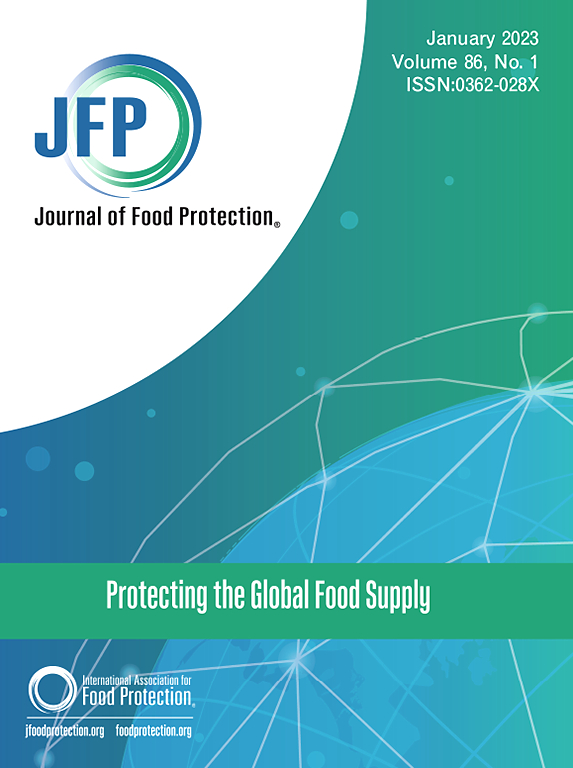通过对内布拉斯加州即食肉类加工企业进行环境监测,分离出了李斯特菌和对季氨消毒剂高度耐药的假单胞菌。
IF 2.1
4区 农林科学
Q3 BIOTECHNOLOGY & APPLIED MICROBIOLOGY
引用次数: 0
摘要
在美国,由于资金、人员或专业知识等方面的限制,对小型和超小型肉类加工厂进行李斯特菌环境监测往往是不可行的。我们使用海绵涂抹器对内布拉斯加州的三家小型/超小型肉类加工厂的非食品接触表面区域进行了采样,以确定假单胞菌的生物膜和耐消毒剂行为是否与即食肉类加工环境中的单增李斯特菌和李斯特菌属的流行有关。3.3%(3/90)的样本对单增李斯特菌呈阳性反应,12.2%(11/90)的样本对李斯特菌呈阳性反应。在对李斯特菌属和假单胞菌属进行生物膜生成和对季氨消毒剂的耐药性检测时,发现了属于这两个菌属的多个能形成生物膜的分离物。四种假单胞菌属分离物对制造商推荐的用于食品接触表面消毒的 200 ppm 消毒剂浓度具有抗性,从单核细胞增多症阳性的下水道样本中分离出的一种假单胞菌属的消毒剂最低杀菌浓度为 1000 ppm。这些发现进一步支持了对小型和超小型肉类加工厂进行单核细胞增多症监测的必要性,并强调了在这些加工环境中识别其他细菌(如假单胞菌)的必要性,这些细菌对环境压力具有抵抗力。本文章由计算机程序翻译,如有差异,请以英文原文为准。
Environmental Monitoring of Nebraska Ready-to-eat Meat Processing Establishments Resulted in the Isolation of Listeria Alongside Pseudomonas Highly Resistant to Quaternary Ammonia Sanitizer
Robust environmental monitoring for Listeria monocytogenes often may not be feasible for small and very small meat processors in the United States due to the limitations in finances, staffing, or expertise. Three small/very small processors in Nebraska were sampled using sponge applicators in nonfood contact surface areas to determine if biofilm and sanitizer resistance behaviors of Pseudomonas could relate to the prevalence of L. monocytogenes and Listeria spp. in ready-to-eat meat processing environments. Samples were 3.3% (3/90) positive for L. monocytogenes, and 12.2% (11/90) of samples were positive for Listeria spp. Pseudomonas spp. were also isolated. When Listeria spp. and Pseudomonas spp. were assayed for biofilm production and resistance to a quaternary ammonia sanitizer, multiple isolates belonging to both genera capable of forming biofilms were identified. Four Pseudomonas spp. isolates resisted the 200 ppm manufacturer-recommended sanitizer concentration for food contact surface sanitation, and one Pseudomonas spp. isolated from a drain sample that was also positive for L. monocytogenes demonstrated a sanitizer minimum bactericidal concentration of 1000 ppm. These findings further support the need for monitoring of small and very small meat processors for L. monocytogenes as well as highlight the need to identify other bacteria in these processing environments, like Pseudomonas, that are resistant to environmental stressors.
求助全文
通过发布文献求助,成功后即可免费获取论文全文。
去求助
来源期刊

Journal of food protection
工程技术-生物工程与应用微生物
CiteScore
4.20
自引率
5.00%
发文量
296
审稿时长
2.5 months
期刊介绍:
The Journal of Food Protection® (JFP) is an international, monthly scientific journal in the English language published by the International Association for Food Protection (IAFP). JFP publishes research and review articles on all aspects of food protection and safety. Major emphases of JFP are placed on studies dealing with:
Tracking, detecting (including traditional, molecular, and real-time), inactivating, and controlling food-related hazards, including microorganisms (including antibiotic resistance), microbial (mycotoxins, seafood toxins) and non-microbial toxins (heavy metals, pesticides, veterinary drug residues, migrants from food packaging, and processing contaminants), allergens and pests (insects, rodents) in human food, pet food and animal feed throughout the food chain;
Microbiological food quality and traditional/novel methods to assay microbiological food quality;
Prevention of food-related hazards and food spoilage through food preservatives and thermal/non-thermal processes, including process validation;
Food fermentations and food-related probiotics;
Safe food handling practices during pre-harvest, harvest, post-harvest, distribution and consumption, including food safety education for retailers, foodservice, and consumers;
Risk assessments for food-related hazards;
Economic impact of food-related hazards, foodborne illness, food loss, food spoilage, and adulterated foods;
Food fraud, food authentication, food defense, and foodborne disease outbreak investigations.
 求助内容:
求助内容: 应助结果提醒方式:
应助结果提醒方式:


